Closed Loop AIO Liquid Coolers: 14-way Mega Roundup Review
by E. Fylladitakis on February 12, 2014 7:00 AM ESTTesting Results, Low Fan Speed (7V)
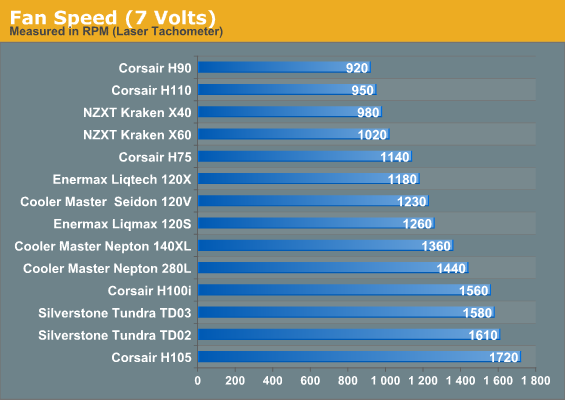
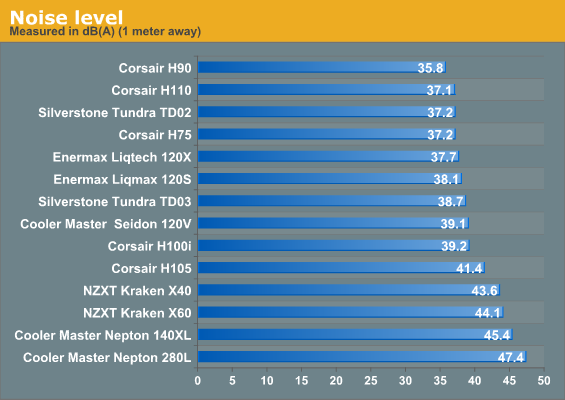
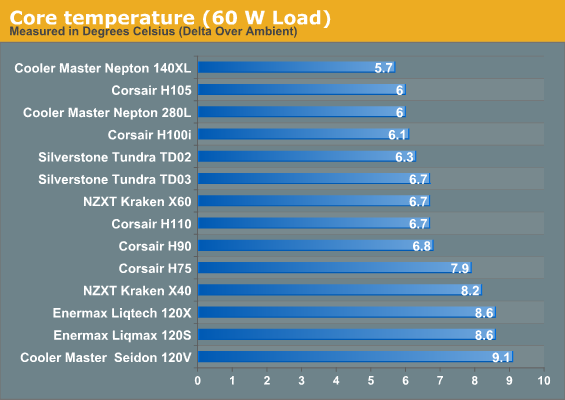

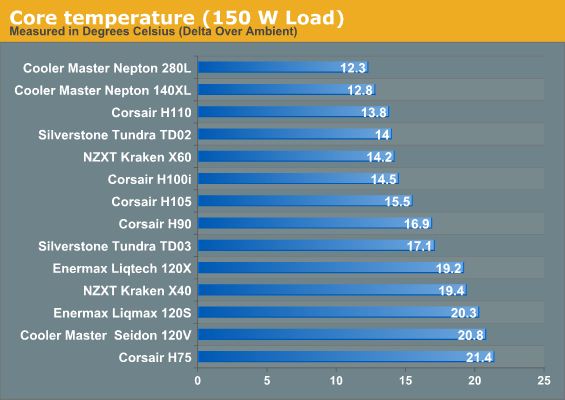
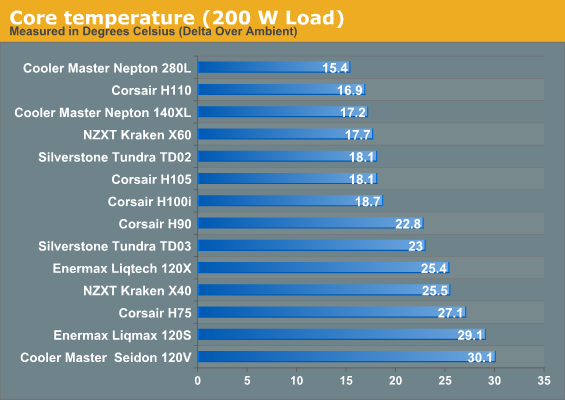
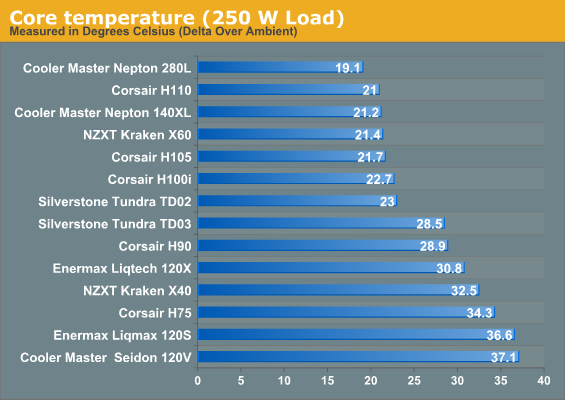
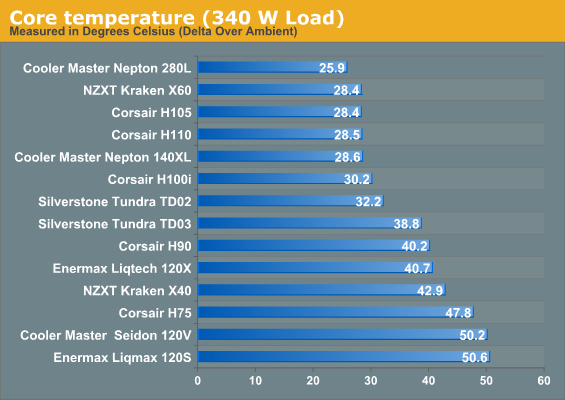
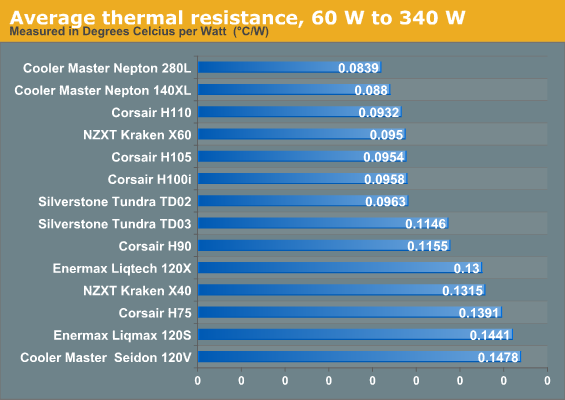
After dropping the voltage of the fans down to 7V, the characteristic performance of several AIO coolers changes quite a bit. As expected, the performance gap between most single and dual fan radiator models widens, as the larger surface maintains a greater heat dissipation rate as the flow rate decreases. The charts are once again led by Cooler Master's Nepton coolers, although that hardly qualifies as "low noise testing" as both coolers still generate high noise levels and are most definitely unsuitable for a low noise environment.
Corsair's H110 displays tremendous thermal performance under very heavy load, in conjunction with very low noise levels. NZXT's Kraken X60 delivers about the same thermal performance, which was to be expected as it virtually is the same design, yet the noise levels are significantly higher; apparently, Corsair chose their fans a bit more wisely (or they just got lucky). Silverstone's Tundra TD02 also fares considerably better this time, rivaling the high load thermal performance of all other 240mm coolers at considerably lower noise levels. Under low thermal loads, the Tundra TD02 manages to outperform most of the dual 120mm and 140mm coolers. Apparently, the large and thick radiator of the TD02 allows it to maintain high performance figures even when the airflow is reduced.
Those who are interested only in noiseless operation and are looking at AIO coolers as a high-performance, low noise alternative to CPU coolers should be careful with their selections. It is not always possible to reduce the speed of the stock fans or replace them in order to reduce the noise generated by the kit. For example, the fan of the Cooler Master Seidon 120V is virtually noiseless when its voltage is dropped down to 7V; the pump however is not, making a clearly audible, high pitch noise. This is also true for the Enermax Liqmax 120S, as the pump of this kit makes a whining noise as well, although the noise of its pump is significantly lower. On the other hand, the Corsair H90 is not the best performing or, due to its size, the most convenient kit of the roundup, yet it is entirely silent when its fan's voltage is reduced down to 7 Volts.










139 Comments
View All Comments
faster - Wednesday, February 12, 2014 - link
I want a closed loop system for my video card!My GTX780 is much louder than my CPU fan.
Liquid cooling was supposed to be how one obtained high performance quiet computing. Air cooling solutions should not be able to compete with a liquid cooling solution in the same environment, but it seems they do. How is that?
blanarahul - Wednesday, February 12, 2014 - link
"I want a closed loop system for my video card!"This. All the stupid OEMs want to disgruntle consumers. We already have more than enough great CPU coolers, but very few great GPU coolers. All I want is a card that is NOT pre-overclocked (but can be overclocked at my whims ;) ) and comes with a all-in-one liquid cooling solution. Is that too much to ask??
E.Fyll - Wednesday, February 12, 2014 - link
Oh, that is coming, soon. Stay tuned, should be online within a couple of weeks. :)Dribble - Wednesday, February 12, 2014 - link
True, for cpu's you don't need that big a cooler - all these lower power Intel cpu's don't pull 200W even overclocked. A big air cooler is sufficient. It'll work as well as a single 120mm fan radiator water cooler but is cheaper and more reliable.However graphics cards are another matter altogether - they pump out huge amounts of heat.
Hence either I WC my graphics card in which case I might as well get a system that can WC my cpu too, or I just stick to air cooling.
BuddhaBum44 - Wednesday, February 12, 2014 - link
You can always get the Kraken X40 and the bracket they make for 780s: https://www.nzxt.com/product/detail/138-kraken-g10...bj_murphy - Wednesday, February 12, 2014 - link
Solid review with some good information. I've been waiting for a "compendium" of sorts to link to people, explaining which closed loop coolers are the best. Thanks E. Fylladitakis, looking forward to more great articles!doggghouse - Wednesday, February 12, 2014 - link
What is a realistic load for a CPU? My 4770K has a max TDP of 84W... and I see a 3960X has a max of 130W. Are there actual CPUs that have anything above that, like 200W - 340W? If not, does it make sense to include those loads in the average thermal resistance, since these AIO coolers are going to be applied to a CPU, not to a synthetic load...?E.Fyll - Wednesday, February 12, 2014 - link
It depends on the CPU, of course. An overclocked CPU can easily surpass their max TDP rating. High thermal loads are useful for the extraction of proper thermal resistance ratings, plus they are easily reachable by modern GPUs (and GPUs are relevant, especially with AIO coolers; you'll see why soon enough). Of course, if you know the power requirements of your current CPU (if not overclocked, about 75% of its TDP), you can easily check the graph closest to it.dragosmp - Wednesday, February 12, 2014 - link
Hi,Great review, I like the methodology. It is nice to see all coolers tested with a constant load that is subject to much less randomness than a CPU power output.
I have two questions:
*is it possible to test all coolers at a certain noise level like 40dB +/-0.5dB; 7V testing is not that relevant for a cooler that is silent @10V, why would anyone silence it even further, save electricity?
*could you provide an order of magnitude of what clock speed and voltage a CPU would need to be at to achieve 340W/150W...etc. It would be useful to get our bearings vs the real world. A chart would be nice a bit like this:
.....................150W.................250W
Haswell DC....4.6GHz/1.25V......
Haswell QC....4.2GHz/1.27V......
FX83xx OC....4.1GHz/1.35V......
The reason for the last remark is that buying decisions are made also with cost in mind. One may think: I have max 30°C Tcase, 4.5GHz Haswell, what is the thermal conductivity I would need so the CPU never passes 70°C? Answer ==> review (maybe not the best cooler, maybe not the most expensive...). I have bought windows for my house like that.
E.Fyll - Wednesday, February 12, 2014 - link
40 dB(A) is not really "silent". I would rate <35 dB(A) as silent and still I can notice that in a very quiet room. 40 dB(A) is a slight humming noise, fairly quiet and most people just ignore it, yet it is easily noticeable. It is an interesting idea but that is not really possible when not all products can do at least 40 dB(A) and not practical, as the motherboard does not read the sound level, it just adjusts the voltage. 7 Volts are just high enough to ensure that (almost) every fan will start and about the same voltage as most motherboard will apply in their "quiet" mode. About the CPUs, I cannot do that as that would require me buying and testing every single CPU, which is not possible. Besides, every CPU is unique and the energy consumption also depends on several settings when overclocked, so it could easily bring misleading results. A single different setting can cause a massive change on consumption at the same exact frequency. For instance, a i7-3820 at 4.4 GHz consumes nearly 20% more energy with its voltage upped by 0.1V. It truly is a very interesting idea but a great deal of data and testing is required to create a proper database.